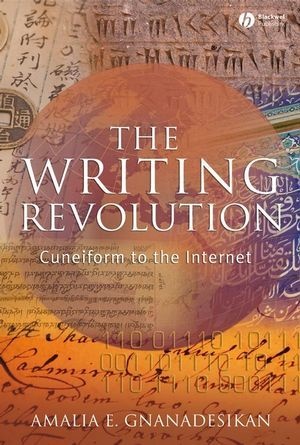Read more
Informationen zum Autor Amalia E. Gnanadesikan teaches writing at Holy Family University and has taught linguistics at West Chester and Rutgers universities. Her theoretical publications include works in phonology and language acquisition. Her column on language, "Postcards from Babel", appears in The Vocabula Review . Klappentext In a world of rapid technological advancement, it is easy to forget that writing is the original Information Technology, created to transcend the limitations of human memory and to defy time and space. The Writing Revolution describes how this communication tool has conquered the world, making possible everything from complex bureaucracy, literature, and science, to instruction manuals and love letters.The author deftly describes each of the world's major written traditions, tracing its origins, the way it captures the language(s) for which it is used, its applications and adaptations, and its cultural impact. From the first cuneiform clay tablet to the World Wide Web - by way of Egyptian hieroglyphs, Japanese syllabaries, and the printing press, among others - this book offers a fascinating insight into the history of one of the world's greatest inventions. Zusammenfassung In a world of rapid technological advancements, it can be easy to forget that writing is the original Information Technology, created to transcend the limitations of human memory and to defy time and space. The Writing Revolution picks apart the development of this communication tool to show how it has conquered the world. Inhaltsverzeichnis List of Illustrations vii Preface xi 1 The First IT Revolution 1 2 Cuneiform: Forgotten Legacy of a Forgotten People 13 3 Egyptian Hieroglyphs and the Quest for Eternity 33 4 Chinese: A Love of Paperwork 56 5 Maya Glyphs: Calendars of Kings 79 6 Linear B: The Clerks of Agamemnon 95 7 Japanese: Three Scripts are Better than One 113 8 Cherokee: Sequoyah Reverse-Engineers 133 9 The Semitic Alphabet: Egypt to Manchuria in 3,400 Years 143 10 The Empire of Sanskrit 169 11 King Sejong's One-Man Renaissance 191 12 Greek Serendipity 208 13 The Age of Latin 229 14 The Alphabet Meets the Machine 249 Appendix: Figures A.1-A.7 273 Further Reading 281 Index 297 ...
List of contents
Preface.
1. The First IT Revolution.
2. Cuneiform: Forgotten Legacy of a Forgotten People.
3. Egyptian Hieroglyphs and the Quest for Eternity.
4. Chinese: A Love of Paperwork.
5. Maya Glyphs: Calendars of Kings.
6. Linear B: The Clerks of Agamemnon.
7. Japanese: Three Scripts are Better than One.
8. Cherokee: Sequoyah Reverse-Engineers.
9. The Semitic Alphabet: Egypt to Manchuria in 3400 Years.
10. The Empire of Sanskrit.
11. King Sejong's One-Man Renaissance.
12. Greek Serendipity.
13. The Age of Latin.
14. The Alphabet Meets the Machine.
Further Reading
Report
"Anyone interested in the development of writing, even without a background in linguistics, will find the book accessible, while linguists will appreciate the well chosen technical information that is included in the description of each individual system." (Language Documentation & Conservation, 2 December 2009)
"This informative, yet accessible and entertaining, book will be of interest to readers with an interest in the history and evolution of world languages, as well as to students and instructors looking for a comprehensive and enjoyable overview of the subject.." ( Language in Society , 14 December 2009)"Gnanadesikan writes about language's evolution into modernity with the rise of technology and the World Wide Web and how writing has made possible everything from complex bureaucracy to love letters." ( Princeton Alumni Weekly Online , February 2009)

